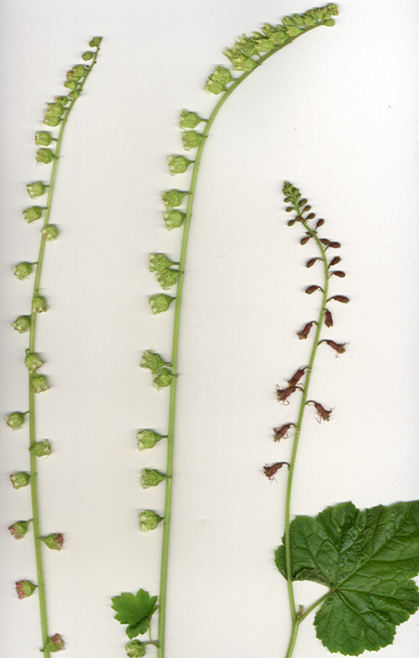| The Saxifrage plant family --as narrowly defined-- has perhaps 660 species, including over 400 members of the genus Saxifraga. Seattle and its nearby environs is or was host to 7 native wildflower species: three common, four rare. Since 21 species of Saxifraga are native in Washington State, it is odd that none grow in Seattle. The city would appear to be too low, dry and forested. Four species grow up in the rocky "Issaquah Alps" however, an area higher in elevation, colder and wetter than Seattle and its other nearby lowland areas. |
| In Seattle gardens, common non-native members of the saxifrage family include several Saxifraga, a plethora in recent years of Heuchera, as well as Astilbe, Bergenia, and rare genera. |
Though usually easy to grow in gardens, these plants are generally not of other significant economic use. Few if any are potently medicinal. None may be notably poisonous, but the astringency, hairy foliage or other objectional factors make few worth eating.
|
| Fringecups |
| Tellima grandiflora (Pursh) Dougl. ex Lindl. 1828 |
| = Mitella grandiflora Pursh 1814 |
| Fringecups is Seattle's most abundant species of the saxifrage family --and one of the city's most common local woodland wildflowers. Native from Alaska to California, Tellima grandiflora is the only member of its genus Tellima --an anagram of Mitella. Named in 1735, Mitella is a diminutive of the Greek mitra, a cap, because the seed capsules look like little caps. The species was first described as Mitella grandiflora in 1814. For, compared to other species of Mitella the flowers are large. |
| It is a tufted evergreen perennial that bears most of its leaves in a basal cluster; the leaves are 2 to 6 inches long, roundish, long-stemmed, and covered with clear hairs. The leaves taste boringly bland and are not poisonous, but herbivores may be discouraged from grazing by the copious hairs. From (late March) late April into June, Fringecups opens cute little flowers --creamy-colored fringed cups, about a third of an inch long, borne on stems 16 to 40 inches high. When numerous blooming fringecups are encountered, acting as a natural woodland groundcover, they present a lovely and fragrant scene. The sweet-tasting blossoms are a pleasant trailside nibble. In age, they turn pinkish or red. |
'Forest Frost', 'Purpurteppich', 'Delphine' and doubtless other cultivars exist, showing distinctive traits. Plants sold as 'Purpurea' or 'Rubra' feature reddish-purple foliage. This species is easy to grow in shady areas, almost weedy. It is naturalized in the British Isles. Some gardeners elsewhere call it False Alumroot.
|
| Youth on Age |
| Tolmiea Menziesii (Pursh) Torr. & Gray |
| Less common overall in Seattle than Fringecups, though in locations such as Fauntleroy Park, it is unusually abundant. This woodland evergreen perennial is native from Alaska to California --the only member of its genus. The generic name honors Dr. William Fraser Tolmie (1812 - 1886), surgeon with the Hudson's Bay Company. |
The slender flowers are relatively dull: dark purple or brownish, veined green, and about half an inch long. They bloom from early April into June, on stems 12 to 36 inches high. Their appearance led to the name Bristle-flower, but the leaves account for the more familiar names of Thousand Mothers and Piggy-back Plant (pick-a-back, pig-a-back). Many of the leaves bear miniature plantlets at the junction of leaf stem and blade, which take root to reproduce the species. Of all Seattle's native wildflowers, this is the only species used as a houseplant. It is also a shade groundcover. The cultivar 'Taff's Gold' features mottled, pale leaves.
|
| Foamflower |
| Tiarella trifoliata L. |
| Foamflower prefers coniferous woods where it ranges: from Alaska into Oregon, east to Montana. It is less common than Youth on Age and Fringecups, but the flowers are prettier and enjoy a longer season. Little white stars shine from often reddish stems, 16 to 24 inches tall, mostly in May and June but continuing sporadically all the way into December. Unlike the preceding duo, the leaves are trifoliate, mostly basal, to 3.5 inches wide. |
Coolwort, Laceflower, and False mitrewort (miterwort) are other names borrowed from its cousins back East.
|
The four rare members of the saxifrage family native in or near Seattle are:
|
| Heuchera chlorantha Piper |
| Tall, Green-flowered, or Meadow Alumroot |
Perennial wildflower of open sites. Extirpated --last collected in 1889.
|
| Heuchera micrantha Dougl. ex Lindl. |
| Small-flowered Alumroot |
Very rare perennial wildflower of moist woods.
|
| Lithophragma parviflorum (Hook.) Nutt. ex Torr. & Gray |
| = Tellima parviflora Hook. 1832 |
| Ragged Starflower; Small-flowered Prairie-star; Small-flowered Fringecups |
Very rare perennial wildflower of moist meadows. I have seen it only at Restoration Point on Bainbridge Island.
|
| Mitella caulescens Nutt. |
| Leafy (-stemmed) Mitrewort or Bishop's cap |
Rare perennial wildflower of wet woods.
|
Here is a scan . . .
Back
|

Tellima and Tolmiea scan by ALJ |

